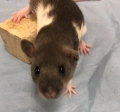

Enhance Rigor and Reproducibility in Animal Research by Managing Extrinsic Factors
When: September 23, 28, and 30, 2022
Venue: Zoom
Register: scgcorp.com/ExtrinsicFactorsWS
The workshop will be a forum to discuss the current status of and needs for understanding extrinsic environmental factors; their potential impact on animal research outcomes; and how facilities may optimally manage, monitor, and report these extrinsic factors in an effort to enhance reproducibility and rigor in animal research. The focus of this workshop will be on identifying gaps, opportunities, and new approaches in husbandry of commonly and widely used animal models; relevant environmental factors and conditions; and the need for novel instruments, equipment, and infrastructure for animal research core facilities (e.g., modern design of research core facilities, high-throughput equipment, telemetry for behavioral research).
The shipping company (courier) is selected by the receiving institution. Upon transfer from the RRRC, animals become the responsibility of the shipper and any issues that arise during the shipping process are between the receiving institution and their chosen courier. Should shipping delays occur, it is the responsibility of the receiving institution to work with the courier to ensure successful shipment. The RRRC cannot be held responsible for loss of animals or health problems that occur once custody of the animals is assumed by the shipper.
If delays occur in shipping, the RRRC can work with the client and shipper to assist in determining an optimal solution. This may include, but is not limited to, having the shipper identify a local source to maintain animals in a temperature controlled environment, checking animal health and supplementing food and water. In cases where extended delay is inevitable, euthanasia may be required. In these situations, the RRRC will determine accessibility of replacement animals, but additional costs to the client (or shipper) will be incurred. Return of animals to the RRRC is not a viable option.
List of Courier Services
